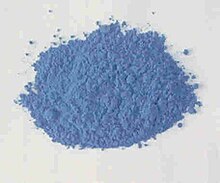埃及蓝
埃及蓝,或称硅酸铜钙(CaCuSi4O10或CaOCuO(SiO2)4),是源于古埃及的一种蓝色合成颜料,被认为是人类历史上最早的人工合成颜料。[1]
| 埃及蓝 | |
|---|---|
| 网页颜色 | #1034A6 |
| RGBB (r, g, b) | (16, 52, 166) |
| CMYH (c, m, y) | (94, 80, 35) |
| CMYKH (c, m, y, k) | (90, 69, 0, 35) |
| HSL (h, s, l) | (226°, 82%, 36%) |
| HSV (h, s, v) | (226°, 90%, 65%) |
| HWB (h, w, b) | (226°, 6%, 35%) |
| B:代表值域介於0~255之間 | |
| H:代表值域介於0~100之間 | |


根据孟菲斯大学埃及学家洛尔莱·科科伦(Lorelei H. Corcoran)的研究,埃及蓝的使用可以追溯到埃及前王朝奈加代三期文化时期。[2]埃及语中称这种颜料为“ḫsbḏ-ỉrjt”,意为“人造青金石”,即是指发明此种颜料的目的是替代昂贵的青金石(ḫsbḏ)颜料。[3]埃及蓝后来流传至欧洲,在古罗马有广泛使用,罗马人称之为“caeruleum”(蔚藍色)。但此后埃及蓝逐渐消失,相关制作技术也随之亡佚。[4]
参见 编辑
参考文献 编辑
- ^ Eastaugh, Nicholas; Walsh, Valentine; Chaplin, Tracey; Siddall, Ruth. Egyptian blue. The pigment compendium: Optical microscopy of historical pigments. Oxford, UK: Elsevier Butterworth Heinemann: 147–148. 2004.
- ^ Lorelei H. Corcoran, "The Color Blue as an 'Animator' in Ancient Egyptian Art", in Rachael B.Goldman, (ed.), Essays in Global Color History: Interpreting the Ancient Spectrum (New Jersey: Gorgias Press, 2016), pp. 59–82.
- ^ Pagès-Camagna, S. (1998). "Bleu et vert égyptiens en question: vocabulaire et analyses". In Colinart S, Menu M, eds., La couleur dans la peinture et l'émaillage de l'Egypte Ancienne, CUEBC, Ravello, 20–22 March 1997, Edipuglia, Bari, pp. 51–59.
- ^ McCouat, Philip. Egyptian blue: The colour of technology. artinsociety.com. Journal of Art in Society. 2018 [2019-05-29]. (原始内容存档于2019-03-28).
- ^ Sir Humphry Davy (1815), "Some experiments and observations on the colours used in painting by the ancients" (页面存档备份,存于互联网档案馆), Philosophical Transactions of the Royal Society of London, vol. 105, pages 97–124. Reprinted in: The Collected Works of Sir Humphry Davy, ... (London, England: Smith, Elder, and Co., 1840), vol. VI, pp. 131–159.
- ^ Tite, M.S., Bimson, M. & Cowell, M.R. The technology of Egyptian blue. M. Bimson; I.C. Freestone (编). Early Vitreous materials. British Museum occasional paper 56. London: British Museum. 1987. ISBN 978-0-86159-056-8.